Shopify Email VS Mailchimp: Detailed Comparison 2025

If you’re reading this, it means you’re currently juggling to find the most suitable email marketing tool for your Shopify store.
And two names on your radar: Shopify Email and Mailchimp. One is built right into the Shopify ecosystem, while the other is a powerhouse that’s been around long enough to set the gold standard.
But which one really makes your life easier? Which one packs the features you need without draining your budget?
So, how do you choose? That’s where this comparison comes in. By the end of this post, you’ll know exactly which platform fits your business needs.
Let’s jump into a straightforward comparison to help you decide.
Comparison: Shopify Email VS Mailchimp
Here’s a quick table to help you evaluate both: Shopify Email and Mailchimp, based on different parameters:
| Feature | Shopify Email | Mailchimp |
| Ease of Use | ✅ Simplified interface for Shopify users | ✅ User-friendly but more complex for beginners |
| Email Builder | ✅ Drag-and-drop editor, basic templates | ✅ Drag-and-drop editor, extensive template library, more advanced design options |
| Template Variety | ❌ Limited selection | ✅ Extensive library with diverse options |
| Design Flexibility | ❌ Minimal customization | ✅ Advanced drag-and-drop editor for flexibility |
| Automation Workflows | ❌ Basic automation for welcome emails, abandoned carts | ✅ Advanced, customizable automation tools |
| Audience Segmentation | ❌ Basic segmentation options based on purchase history | ✅ Highly detailed segmentation options |
| A/B Testing | ❌ Not currently available | ✅ Robust A/B testing features |
| Integration with Shopify | ✅ Native integration with Shopify | ✅ Available but requires setup via app |
| Integration with Other Platforms | ❌ Limited integrations | ✅ Broad range of third-party integrations |
| Reporting & Analytics | ✅ Simple, key metrics | ✅ Comprehensive reporting with advanced insights |
| Pricing | ✅ More affordable for small businesses | ❌ Can be expensive as the contact list grows |
| Scalability | ❌ Limited scalability for growing businesses | ✅ Designed to scale for large enterprises |
| Free Plan Availability | ✅ Free up to 10,000 emails/month | ❌ Free plan available with limited features |
| Support Options | ✅ Shopify support included | ✅ Extensive resources and 24/7 customer support |
| SMS Marketing | ❌ No built-in SMS marketing | ✅ Offers SMS marketing capabilities as an add-on |
Note: I have aimed to provide an objective comparison based on publicly available information. This table provides a general overview. Features and pricing are subject to change. Refer to the official Shopify Email and Mailchimp websites for the most up-to-date information.
Shopify Email
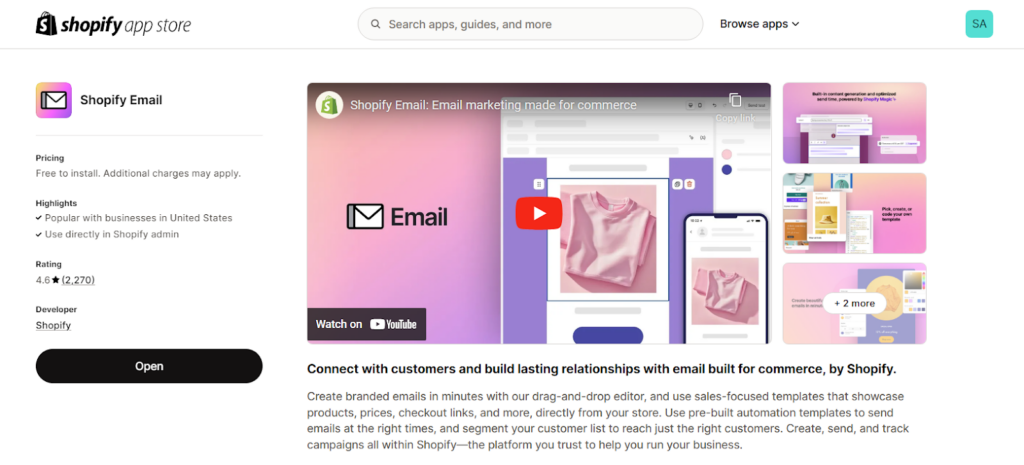
Shopify Email feels like it was built with Shopify store owners in mind because, well, it was. If you’re already managing your business on Shopify, adding email marketing to your workflow feels effortless.
Key Highlights:
- Pre-designed templates that seamlessly match your Shopify store branding.
- Easy-to-use campaign and automation templates to get started quickly.
- Includes up to 10,000 emails per month as part of your Shopify plan—no extra cost!
If you’re running a Shopify store and need a tool that “just works” without breaking the bank, Shopify Email is a no-brainer. It’s simple, affordable, and perfectly tailored to e-commerce newbies and smaller mailing lists.
Mailchimp
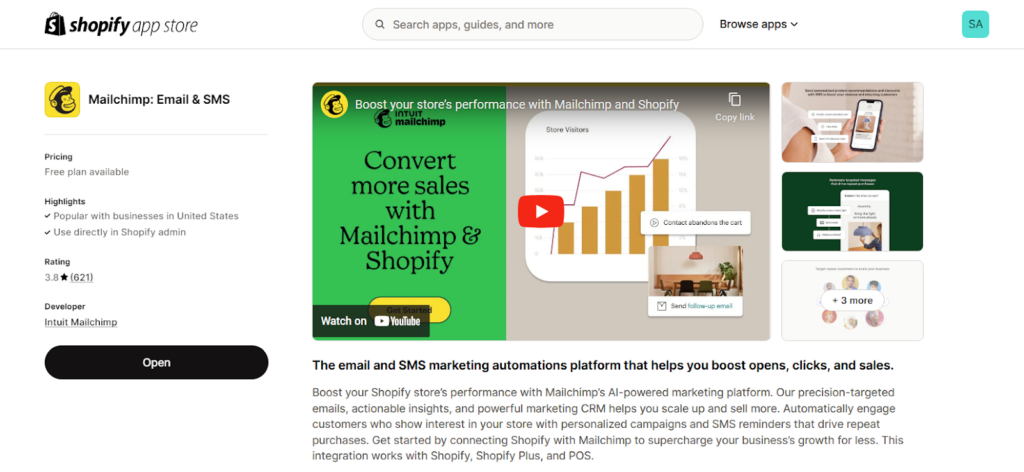
Mailchimp is like the army of email marketing—versatile and packed with features. If you’re after advanced automation, in-depth customizations, or running a large-scale email operation, Mailchimp offers the kind of powerful marketing CRM that justifies its price tag.
Key Highlights:
- Sophisticated automation tools let you set up personalized email journeys.
- The email builder is robust, with support for video, surveys, customer reviews, and even dynamic product recommendations.
- Premium features like advanced analytics and segmentation shine on their Standard Plan.
At the end of the day, it’s all about matching the tool to your needs—whether that’s simplicity or sophistication.
Let’s break it down in the next section.
Shopify Email & Mailchimp: Detailed Feature Comparison
To understand the clear difference between the options (Shopify Email and Mailchimp), you need to know how each platform caters to your email marketing goals, the depth of features they provide, and the unique advantages they bring to the table.
So let’s explore feature-wise and see how Shopify Email and Mailchimp measure up in the areas that matter most.
1—User interface and experience
No one wants to spend hours figuring out how to send a simple email. That’s why user interfaces is the first factor to consider.
Shopify Email
Shopify Email keeps things as straightforward as possible. If you’re already running a Shopify store, using Shopify Email feels like you’re flipping to a new tab in the same browser.
The interface is clean, minimal, and purpose-built for store owners. It’s like adding another tool to your toolkit without the hassle of learning how it works.
Everything is well-designed, from selecting templates to tracking your email performance. It’s straightforward without being overly basic—a perfect fit for someone who values efficiency over endless options.
Mailchimp
Mailchimp, on the other hand, takes a more complex approach. There’s a tool for everything, but you might need to spend a little time figuring out what goes where.
Mailchimp’s interface is packed with features, but that also means there’s a learning curve. The navigation requires a bit of patience, especially for beginners.
However, for marketers who want to dig deep into analytics, refine audience segments, or test every creative variation, the extra complexity is worth it.
| Shopify Email | Mailchimp |
| ✅ Simple & intuitive ✅ Feels like a built-in Shopify tool ✅ Clean, clutter-free interface | ❌ More complex, steeper learning curve ❌ Requires setup & adjustments ❌ Feature-packed but overwhelming |
For someone who loves exploring and tweaking every option, it’s a paradise. But if simplicity is your thing, Mailchimp might feel a little overwhelming.
2—Email Design and Customization
When it comes to designing emails, both Shopify Email and Mailchimp make a strong case for themselves, but the real winner depends on your specific needs.
Shopify Email
Right out of the box, the app automatically pulls your store name, brand colors, fonts, and other information from your Shopify store, making your email templates feel instantly professional and on-brand. It’s like having a personal designer who already knows your style.
Shopify offers 71 responsive templates that adapt beautifully to screens of all sizes.
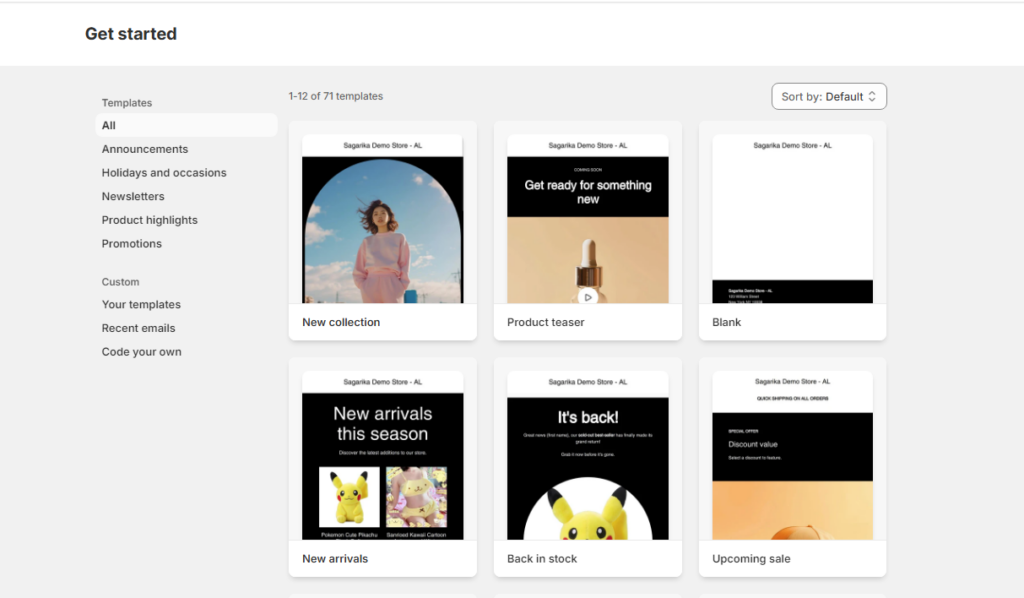
The drag-and-drop editor is clean and easy to use, allowing you to create polished campaigns without fuss.
However, Shopify Email keeps it basic when it comes to customization. It doesn’t include some of the advanced content blocks Mailchimp offers, like video, surveys, or customer reviews.
Personalized product recommendations in campaigns also require additional apps, which might limit some creative possibilities.
Mailchimp
With 139 basic templates (though only seven are available on the free plan), you’ll find something for nearly every campaign type.
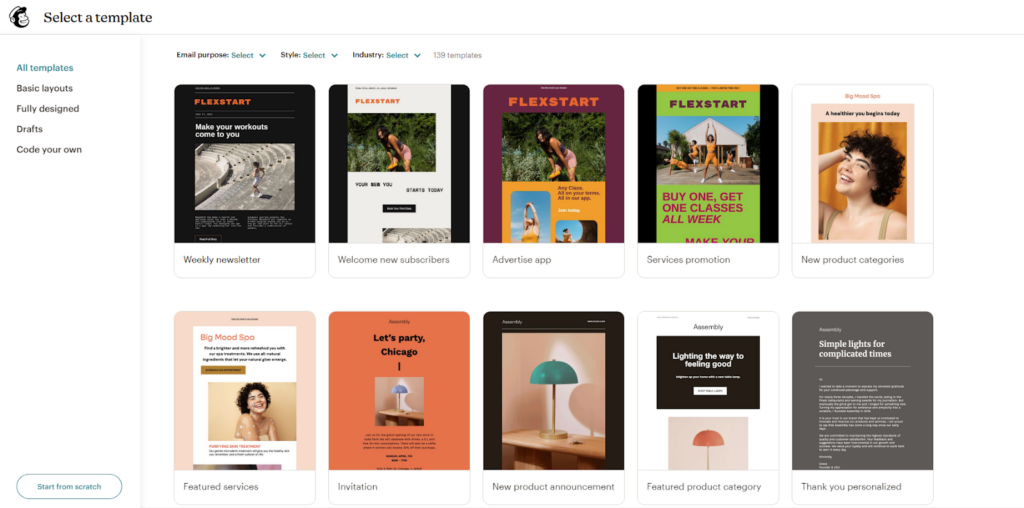
Mailchimp’s drag-and-drop builder includes advanced content blocks such as videos, surveys, and dynamic product recommendations.
These recommendations can be adjusted based on a recipient’s cart, browsing history, or best-sellers—offering a level of personalization Shopify Email doesn’t provide out of the box.
Mailchimp also has a Creative Assistant, which helps generate branded designs. While this feature is only available on the Standard Plan and up, it’s a handy tool when it works. That said, it’s not without flaws, as glitches like blank placeholders and logo resizing issues occasionally crop up.
| Shopify Email | Mailchimp | |
| Automatically pulls store branding | ✅ Yes | ❌ No |
| Number of templates | 71 | 139 |
| Drag-and-drop editor | ✅ Yes | ✅ Yes |
| Responsive templates | ✅ Yes | ✅ Yes |
| Advanced content blocks (videos, surveys, reviews, etc.) | ❌ No | ✅ Yes |
| Creative Assistant for branded designs | ❌ No | ✅ Yes |
In short, Shopify Email prioritizes ease and simplicity for e-commerce-focused users, while Mailchimp is for marketers who want maximum creative control and customization.
3—Automation Capabilities
Automation is where email marketing platforms really prove their worth. After all, who has time to manually send follow-ups or welcome emails when you could be focusing on growing your business?
Let’s see how Shopify Email and Mailchimp tackle this essential feature.
Shopify Email
Shopify Email keeps things straightforward, offering a handful of essential automation templates, such as welcome emails, abandoned cart reminders, and order confirmations—enough to cover the basics for most e-commerce businesses.
If you’re looking to create something unique and complex, Shopify Flow steps in. Available with all paid Shopify plans, Flow lets you build custom workflows using triggers, conditions, and filters.
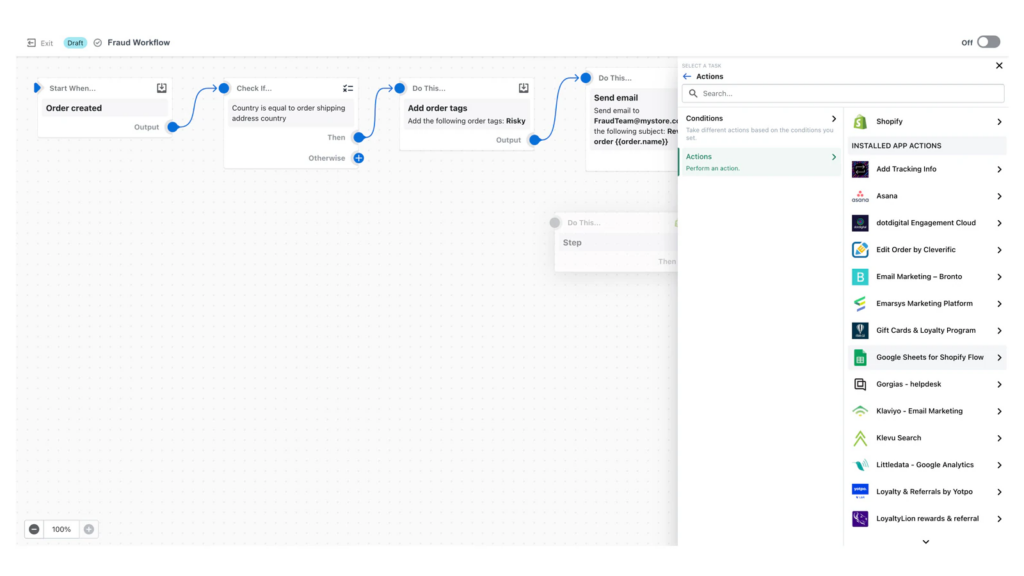
It’s a practical solution if your focus is on streamlining e-commerce processes without venturing too far into complex automation territory.
Mailchimp
Mailchimp’s standout feature is the customer journey builder, offering over 100 pre-built templates to customize. This tool isn’t just about sending emails—it’s about crafting an entire experience, from personalized onboarding sequences to re-engagement campaigns.
Here’s an example of MailChimp’s prebuild user journey:
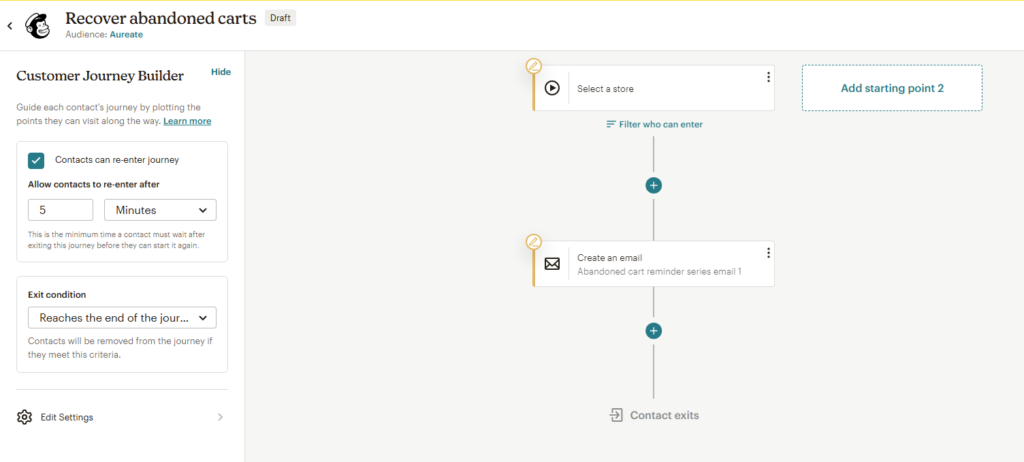
With Mailchimp, you can layer triggers, actions, and conditions to create workflows that adapt to user behavior, making it ideal for businesses with sophisticated marketing needs.
But here’s the catch: The Essentials plan only allows four journey points, and even the Standard plan caps it at 200 journey points. Shopify, in contrast, doesn’t impose usage restrictions on its automation features, providing more flexibility for businesses scaling their campaigns.
| Shopify Email | Mailchimp | |
| Basic Automation Templates (Welcome emails, abandoned cart, order confirmation) | ✅ | ✅ |
| Advanced Automation Builder | ⚠️ (Limited) | ✅ |
| Pre-built Automation Templates | ❌ | ✅ |
| Custom Workflow Creation | ✅ (With Shopify Flow) | ✅ |
| Behavior-Based Triggers | ⚠️ (Limited) | ✅ |
| Usage Restrictions on Automation | ✅ (Unlimited) | ❌ (Limited based on plan) |
Ultimately, your choice will depend on whether you need straightforward automation that integrates seamlessly with your store or a feature-rich platform to supercharge your marketing campaigns.
4—Segmentation and Targeting
You can’t send every email to everyone, and that’s why there’s a need for segmentation for better email marketing.
Shopify Email
One of Shopify Email’s standout features is everything is housed under the Customers tab in your Shopify dashboard, so you don’t have to hunt for it. This gives you a significant head start when segmenting your audience.
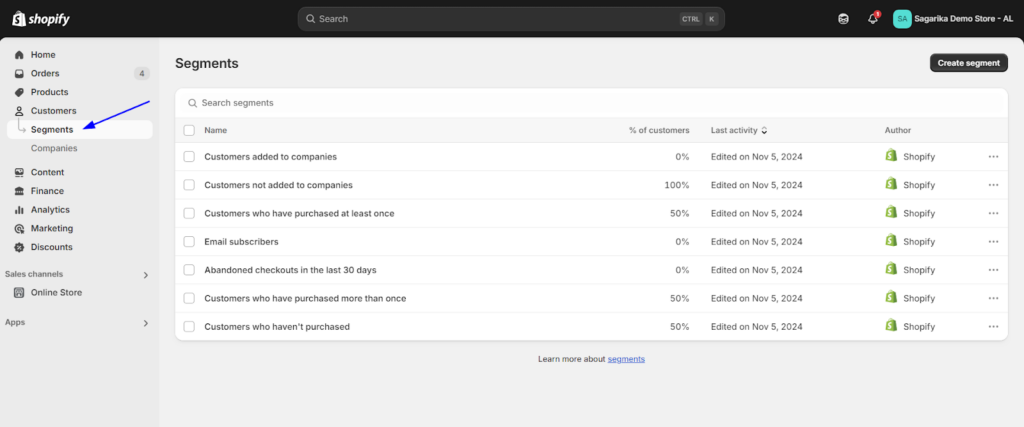
Instead of manually importing data or jumping through hoops, you can use Shopify’s built-in customer segments right from your dashboard.
Filters like location, amount spent, purchase history, or even predicted spend tiers make it easy to group your audience in meaningful ways.
Mailchimp
Mailchimp takes segmentation to another level. Its platform allows you to create detailed, multi-condition segments.
You can add up to five conditions per segment, using “AND” or “OR” operators to build hyper-targeted lists. Whether it’s contacts’ demographics, acquisition source, ecommerce behavior, or email engagement metrics, Mailchimp ensures you can slice and dice your audience as much as you need.
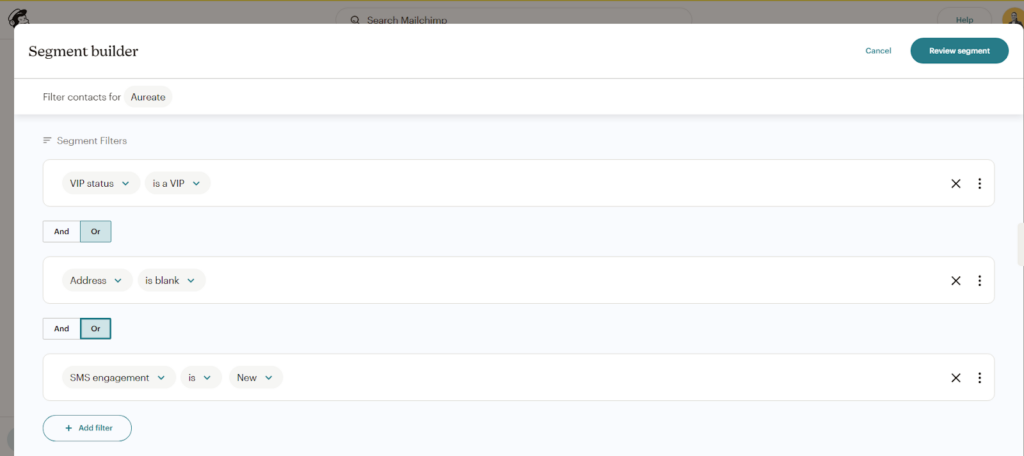
For example, you could target customers who’ve opened three of your last five emails, spent over $100 in the past month, and browsed a specific product category on your website. That level of granularity is a huge win for marketers looking to fine-tune their campaigns.
In a nutshell, Shopify Email excels at making segmentation easy for e-commerce store owners, while Mailchimp provides more than enough firepower to create targeted campaigns that drive results.
5—Advanced Features
At some point, your email marketing may outgrow the basics, and you’ll need more robust tools to level up your strategy. This is where Shopify Email and Mailchimp take very different paths.
Shopify Email
Shopify Email is like a reliable car—it gets you from point A to B without any unnecessary distractions. It’s excellent for running simple, effective email campaigns, but it’s not designed to be a one-stop marketing solution.
For example, A/B testing isn’t natively supported. Sure, you can work around it with third-party apps or by manually segmenting your audience, but that’s not exactly efficient.
The same goes for predictive analytics or SMS campaigns—Shopify doesn’t offer them out of the box, so you’d need to rely on paid apps, which can add up quickly in cost.
Mailchimp
Now, Mailchimp is the opposite.
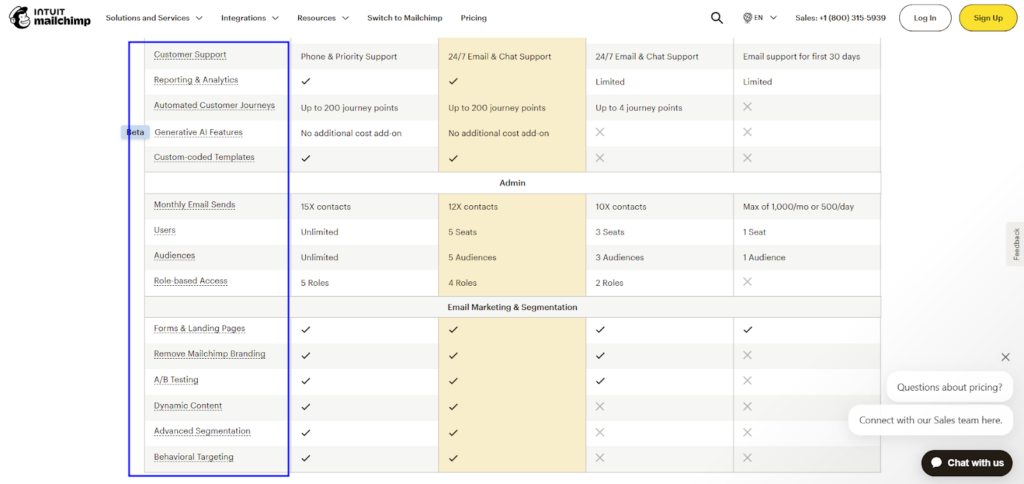
Features like built-in A/B testing let you experiment with subject lines, send times, or designs without extra hassle.
Their predictive analytics help you forecast performance, while push notifications, SMS campaigns, and social media tools give you multi-channel marketing power.
Plus, comparative benchmark reporting helps you understand how your campaigns stack up against similar businesses.
If your strategy goes beyond email and you want everything under one roof, Mailchimp’s advanced features make it worth the investment.
| Shopify Email | Mailchimp | |
| Built-in A/B Testing | ❌ No | ✅ Yes |
| Predictive Analytics | ❌ No | ✅ Yes |
| SMS Campaigns | ❌ No | ✅ Yes |
| Push Notifications | ❌ No | ✅ Yes |
| Social Media Marketing Tools | ❌ No | ✅ Yes |
| Comparative Benchmark Reporting | ❌ No | ✅ Yes |
| Multi-Channel Marketing | ❌ No | ✅ Yes |
Ultimately, your choice will depend on your business’s growth revolution. If you’re focused on running a straightforward e-commerce store, Shopify Email will likely meet your needs. But if you’re building a marketing department that goes beyond email, Mailchimp’s advanced features could be worth the investment.
6—Analytics and Reporting
When it comes to tracking the success of your email campaigns, you need tools that provide clear insights and help you make data-driven decisions.
Shopify Email
Shopify Email is built with eCommerce in mind, so it shines when it comes to tracking how email campaigns impact your sales and customer behavior. You’ll get essential metrics like open rates, click-through rates, and unsubscribe rates, but where Shopify really excels is in its order-related insights. You can track:
- Total sales from email campaigns
- Average order value
- Average products sold
- Number of first-time customers
Additionally, Shopify Email provides insights into how customers interact with your site after reading your emails.
This eCommerce-specific data is fantastic for understanding how email impacts customer behavior. However, if you want more in-depth analytics or tools for tracking customer behavior beyond the shopping cart, you might hit some limits with Shopify Email.
Mailchimp
Mailchimp takes a broader approach, offering analytics that spans beyond just email campaigns. It tracks basic metrics like open and click rates, but what sets Mailchimp apart is its deeper customer insights. You can assess:
- Customer likelihood to repurchase
- Social media and landing page engagement
- Activities generating leads
If you’re using tools like Google Analytics, you can pull that data right into Mailchimp, allowing for richer insights into your customer behavior. However, when it comes to eCommerce-specific insights like total sales or first-time customer tracking, Mailchimp is a little more basic than Shopify Email.
Additionally, Mailchimp gives you comparative benchmarking reports. This feature allows you to compare different audience segments to see which ones perform best.
| Shopify Email | Mailchimp | |
| Open Rate Tracking | ✅ Yes | ✅ Yes |
| Click-Through Rate Tracking | ✅ Yes | ✅ Yes |
| Unsubscribe Rate Tracking | ✅ Yes | ✅ Yes |
| Total Sales from Email Campaigns | ✅ Yes | ❌ No |
| Average Order Value | ✅ Yes | ❌ No |
| Average Products Sold | ✅ Yes | ❌ No |
| Number of First-Time Customers | ✅ Yes | ❌ No |
| Customer Behavior Insights (eCommerce) | ✅ Yes | ❌ Basic |
| Customer Likelihood to Repurchase | ❌ No | ✅ Yes |
| Social Media and Landing Page Engagement | ❌ No | ✅ Yes |
| Lead Generation Tracking | ❌ No | ✅ Yes |
| Google Analytics Integration | ❌ No | ✅ Yes |
| Comparative Benchmark Reports | ❌ No | ✅ Yes |
While Shopify can provide individual campaign reports, it doesn’t give you the ability to measure your performance against other campaigns or segments, which is a major advantage of Mailchimp for businesses looking to optimize based on detailed data.
If you’re looking for advanced analytics that goes beyond the basics, Mailchimp’s richer data and integrations make it the stronger contender.
7—Integration Capabilities
Integration capabilities are crucial for syncing your email campaigns with other tools you use to manage your business.
Shopify Email
Shopify Email is designed to work seamlessly with Shopify’s eCommerce platform, which is great for Shopify merchants. Since it’s built right into the Shopify ecosystem, it’s easy to get started without needing to manage additional integrations.
It integrates directly with your Shopify store to track purchases, abandoned carts, and customer behavior. However, it doesn’t offer as many integrations with third-party tools outside the Shopify universe.
Mailchimp
Mailchimp, on the other hand, offers a massive library of integrations—over 300, to be exact. This means you can connect with everything from CRM tools like Salesforce and HubSpot to analytics platforms like Google Analytics, social media tools like Facebook Ads, and even customer service tools like Zendesk.
Suppose your business uses a mix of different platforms for marketing, customer management, or sales. In that case, Mailchimp’s ability to integrate with a wide range of tools makes it a more versatile option.
| Shopify Email | Mailchimp | |
| Integrates with Shopify Store | ✅ Yes | ✅ Yes |
| Third-Party Tool Integrations | ❌ Limited | ✅ 300 integrations |
| CRM Integrations (e.g., Salesforce, HubSpot) | ❌ No | ✅ Yes |
| Analytics Integrations (e.g., Google Analytics) | ❌ Indirect | ✅ Yes |
| Social Media Tool Integrations (e.g., Facebook Ads) | ❌ Indirect | ✅ Yes |
While Mailchimp’s Shopify integration is also available, it’s worth noting that some of its more advanced features, like abandoned cart emails or product recommendations, are available only on paid plans.
8—Pricing Structures
Pricing is the key deciding factor for many businesses, especially small businesses with less budget. Shopify Email and Mailchimp take very different approaches to pricing, so let’s break it down.
Shopify Email
Shopify Email keeps things simple and budget-friendly. As a Shopify merchant, you get 10,000 emails for free every month, which is a huge advantage for small and growing stores.
Beyond that, you pay based on usage:
- $1 per 1,000 emails (up to 300,000 emails/month)
- $0.65 per 1,000 emails (300,000–750,000 emails/month)
- $0.55 per 1,000 emails (750,000+ emails/month)
Since Shopify Email is integrated directly into Shopify, there are no extra subscription fees. You pay only for what you use, making it a cost-effective choice for Shopify store owners who need basic email marketing without committing to a monthly plan.
However, keep in mind that Shopify Email lacks some advanced features, which may require additional paid apps.
Mailchimp
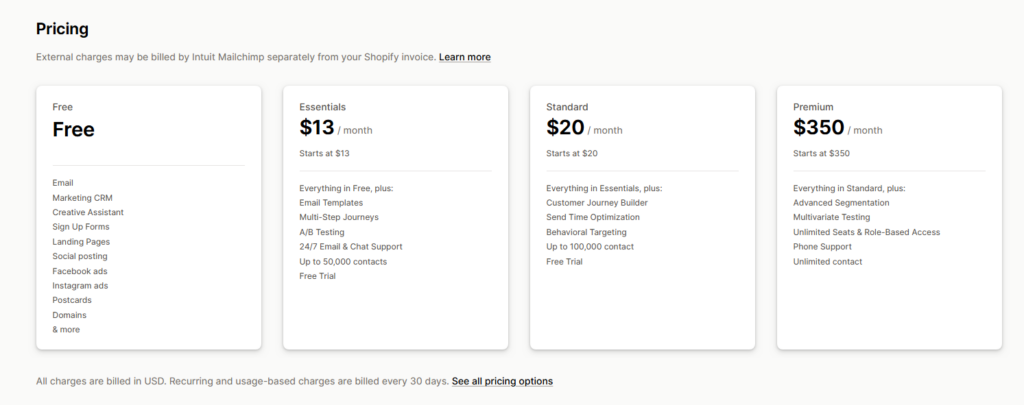
Mailchimp operates on a tiered pricing model based on the number of subscribers and emails you send.
The higher the plan, the more features you unlock:
- Free Plan: Up to 1,000 emails/month, but with very limited features (no automation, few templates).
- Essentials Plan: Starts at $13/month for 5,000 emails and 500 subscribers.
- Standard Plan: Starts at $20/month for 6,000 emails and 500 subscribers.
- Premium Plan: Starts at $350/month for 150,000 emails and 10,000 subscribers.
Mailchimp’s pricing can add up quickly, especially as your list grows. It also charges for each unique subscriber, even if they appear on multiple lists, which can lead to higher costs.
| Shopify Email | Mailchimp | |
| Plan | ✅ 10,000 emails/month | ✅ 1,000 emails/month |
| Cost for Additional Emails | ✅ $1 per 1,000 emails (up to 300k) | ❌ Not available |
| Tiered Plans | ✅ Simple usage-based pricing | ✅ Multiple tiered plans with varied features |
| Automation Included | ❌ Requires additional paid apps | ✅ Available on higher-tier plans |
| Advanced Features | ❌ Requires paid apps for advanced tools | ✅ Built-in advanced features |
| Customizable Plans | ✅ Pay as you go based on usage | ✅ Tiered plans for different business needs |
If you’re just starting with email marketing and want to keep costs low, Shopify Email is a great starting point. But if you’re running complex email campaigns and need more automation and analytics, Mailchimp justifies its higher price with a broader set of features.
9—User Reviews
When choosing between Shopify Email and Mailchimp, it’s essential to consider feedback from fellow Shopify merchants who have hands-on experience with these tools. Their insights can provide a clearer picture of what to expect.
That’s why we are focusing the reviews on Shopify App Store.
Shopify Email
Shopify Email has a commendable rating of 4.6 out of 5 stars based on over 2,270 reviews.
Merchants appreciate its seamless integration with Shopify, user-friendly interface, and the convenience of managing email campaigns directly from the Shopify admin panel.
However, some users have noted limitations in advanced features, such as the absence of built-in A/B testing and more sophisticated automation capabilities.
For businesses seeking straightforward email marketing solutions that are tightly integrated with their Shopify store, Shopify Email is often praised as a solid choice.
Mailchimp
Mailchimp holds a rating of 3.8 out of 5 stars on the Shopify App Store, with over 621 reviews.
Users value its extensive feature set, including advanced automation, comprehensive analytics, and a wide array of customizable templates.
The ability to integrate with various third-party applications is also a significant advantage. On the flip side, some merchants have reported challenges with the initial setup and a steeper learning curve.
Additionally, concerns about pricing, especially as subscriber lists grow, have been highlighted.
Despite these challenges, Mailchimp remains a popular choice for businesses that require robust email marketing capabilities and are willing to invest time in mastering the platform.
Final Thoughts: Which One is Better?
Fast forward to today, email marketing is no longer just a “nice-to-have” for e-commerce businesses—it’s a must-have. Shopify Email, a relatively new contender launched in 2019, has entered the ring alongside veterans like Mailchimp, which has been shaping email campaigns since 2001.
So, does Mailchimp’s nearly 20-year head start automatically make it the better choice?
Well, not quite. These tools cater to different needs and excel in their unique ways. Choosing the right one boils down to a few key factors:
- The size of your mailing list and how often you send emails.
- Your appetite for email marketing automation.
- Whether you need tools beyond emails, like SMS or social media marketing.
As someone who’s built countless campaigns on Mailchimp (and even shelled out for a paid plan), it’s powerful. But when it comes to a beginner store’s needs, Shopify Email’s cost-effectiveness for smaller list sizes can be a better fit. Your decision might hinge on a similar consideration.
If you need expert advice or looking for a team that can make your email campaigns smarter, more effective, and tailored to your unique needs, we’re here to help.






Post a Comment
Got a question? Have a feedback? Please feel free to leave your ideas, opinions, and questions in the comments section of our post! ❤️